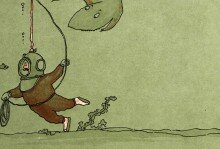Where Manhattan Meets the Mahabharata
A review of Vijay Seshadri’s The Disappearances
When I began Vijay Seshadri’s The Disappearances I believed I was on reasonably familiar terrain – attractive but not immediately surprising. There was intellectual energy, linguistic ingenuity and formal accomplishment. Given how scarce some of these qualities have become, I was also grateful. There seems to be far too much poetry that is ready to justify grammatical mayhem and verbal flaccidity on the grounds of “real feeling” and “cultural authenticity”. Thankfully, Seshadri’s work did neither.
Writers are first and foremost lovers of words – a fact often forgotten by an instrumental world that no longer has the time for the gourmet aspects of poetry. I enjoyed Seshadri’s excitement over juicy polysyllabic words: ‘fenestrate’, ‘farinaceous’, ‘cinerarium’, ‘eleemosynary’. Even while I had momentary twinges over certain zeitgeisty words – ‘inscape’ and ‘implode’ – it was refreshing to find poetry that celebrated a certain linguistic complexity, instead of the verbal frugality that seems to have become an unexamined creative choice.
It is as the book progressed that I encountered poems that seemed not merely about bravura moments, but about something more compelling. The book is essentially a collection of two volumes of poetry: Wild Kingdom (1996) and The Long Meadow (2004). The later poems appear to emerge from deepening states of immersion, from that point where philosophical reflection meets a less self-conscious technique.
There are several poems of striking image and dexterously turned phrases: “The sun over Jersey / kicks and drops / into the next of its readymade slots” and “the alders / are nervous with change”, for example. But it is some of the longer poems that made me realise the depth and ambit of Seshadri’s poetic project.
The first book contains the strange and interesting long poem, ‘The Lump’, which relates the tale of human encounter – with all its eternally unexplained mysteries – against the hypnotic backdrop of a restless Pacific ocean. Another arresting poem is ‘Lifeline’ – about a man’s accidental and terrifying discovery of his own nothingness and “the annihilating dimensions” of the universe he inhabits – where words such as ‘infinite’ and ‘eternal’ turn “suddenly ridiculous in their inadequacy”. One already glimpses here Seshadri’s preoccupations with the nature of human life, with notions of time and space. It is in the second book, however, that they become more overtly manifest.
The classic life-in-transit New York poem, ‘North of Manhattan’, in the second book, gives us the wonderful image of the body – “ecstatic in its finitude” – breaking free of the shackles of the mind and careening between worlds, even as the mind pants along, trying to keep pace, “straining / from the past to the vanishing present”, but perennially caught in “this tunnel of its forever”. There is a brief glimpse of liberation, however – the possibility of dream – but even this is contingent on taking the bus north of Manhattan, when the body unwarily “relaxed on its contoured plastic seat” allows the mind a quick fugitive flight of fancy.
There’s the ambitious and dense prose piece, ‘The Nature of the Chemical Bond’, in which the poet offers us the portrait of a father, a new immigrant, obsessively fascinated by the empirical details of American Civil War history, a man whose “passage to America”, had “thrown him free, but . . . had also stripped him down to its naked soul”. From childhood memories of interminable car journeys spent captive in the backseat, the poet offers us a moving account of cultural transition and identity, but above all, of a son’s changing relationship with his father – embarrassed, exasperated, affectionate, deeply credible.
It is these pieces that probe relationships – ‘Baby, Baby’ being another – that reveal Seshadri’s ability to move with tonal ease and fluidity between the singular and the archetypal, the tender and the meditative. My personal favourite remains the title poem, ‘The Long Meadow’, in which a relationship with a dog is invoked with all its particular and mythic resonances. Seshadri finds a loping, unleashed stride in this paean to a mongrel dog, matching scale with tone, mood with pitch, seguing between the measured line and melodic incantation. There is no straining after effect. The poem presents a heady mix of grace and temerity and understatement – the ideal note on which to conclude this rewarding book.
The Disappearances: Poems by Vijay Seshadri
HarperCollins Publishers India (with The India Today Group), New Delhi, 2007
ISBN: 978 81 0 223 693 9
It is as the book progressed that I encountered poems that seemed not merely about bravura moments, but about something more compelling. The book is essentially a collection of two volumes of poetry: Wild Kingdom (1996) and The Long Meadow (2004). The later poems appear to emerge from deepening states of immersion, from that point where philosophical reflection meets a less self-conscious technique.
There are several poems of striking image and dexterously turned phrases: “The sun over Jersey / kicks and drops / into the next of its readymade slots” and “the alders / are nervous with change”, for example. But it is some of the longer poems that made me realise the depth and ambit of Seshadri’s poetic project.
The first book contains the strange and interesting long poem, ‘The Lump’, which relates the tale of human encounter – with all its eternally unexplained mysteries – against the hypnotic backdrop of a restless Pacific ocean. Another arresting poem is ‘Lifeline’ – about a man’s accidental and terrifying discovery of his own nothingness and “the annihilating dimensions” of the universe he inhabits – where words such as ‘infinite’ and ‘eternal’ turn “suddenly ridiculous in their inadequacy”. One already glimpses here Seshadri’s preoccupations with the nature of human life, with notions of time and space. It is in the second book, however, that they become more overtly manifest.
The classic life-in-transit New York poem, ‘North of Manhattan’, in the second book, gives us the wonderful image of the body – “ecstatic in its finitude” – breaking free of the shackles of the mind and careening between worlds, even as the mind pants along, trying to keep pace, “straining / from the past to the vanishing present”, but perennially caught in “this tunnel of its forever”. There is a brief glimpse of liberation, however – the possibility of dream – but even this is contingent on taking the bus north of Manhattan, when the body unwarily “relaxed on its contoured plastic seat” allows the mind a quick fugitive flight of fancy.
There’s the ambitious and dense prose piece, ‘The Nature of the Chemical Bond’, in which the poet offers us the portrait of a father, a new immigrant, obsessively fascinated by the empirical details of American Civil War history, a man whose “passage to America”, had “thrown him free, but . . . had also stripped him down to its naked soul”. From childhood memories of interminable car journeys spent captive in the backseat, the poet offers us a moving account of cultural transition and identity, but above all, of a son’s changing relationship with his father – embarrassed, exasperated, affectionate, deeply credible.
It is these pieces that probe relationships – ‘Baby, Baby’ being another – that reveal Seshadri’s ability to move with tonal ease and fluidity between the singular and the archetypal, the tender and the meditative. My personal favourite remains the title poem, ‘The Long Meadow’, in which a relationship with a dog is invoked with all its particular and mythic resonances. Seshadri finds a loping, unleashed stride in this paean to a mongrel dog, matching scale with tone, mood with pitch, seguing between the measured line and melodic incantation. There is no straining after effect. The poem presents a heady mix of grace and temerity and understatement – the ideal note on which to conclude this rewarding book.
The Disappearances: Poems by Vijay Seshadri
HarperCollins Publishers India (with The India Today Group), New Delhi, 2007
ISBN: 978 81 0 223 693 9










